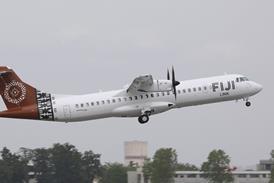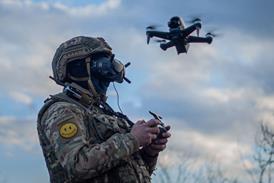Max Kingsley-Jones/FARNBOROUGH
Airbus Industrie's recent, relentless pounding of Boeing continued through the Farnborough air show week, with the European consortium announcing some $12 billion worth of sales, taking orders past 3,000. The string of recent successes, combined with a new product launch, look set to ensure that Airbus will indeed achieve its long stated goal of delivering half of the world's jet airliners annually from early in the new millennium.
The deals at Farnborough included some 26 orders and options for the new A340-500/600 family, including a 16-aircraft contract from Emirates in the face of stiff competition from Boeing's rival 777. UPS also confirmed an important 60-aircraft deal for A300-600 freighters, providing a lifeline for the oldest type in the Airbus product line and breathing space for the development of a follow-on aircraft.
The 130-plus orders and options announced at the show, along with the announcement of a new 100-seat A320 derivative which extends the consortium's product line down as low as Boeing's, firmly established Airbus as the glory taker at the show. As a precursor to Farnborough, Airbus scooped up a major Boeing customer, British Airways, which has signed for up to 188 A320s.
The Airbus share of the order backlog has now passed through the 40% mark for the first time. The ferocious sales battles over recent years have seen both Airbus, and its US rival, pushed through the pain barrier, with the Europeans capitalising on Boeing's own self-inflicted production problems.
PRICE PRESSURE
John Leahy, Airbus senior vice-president commercial, points out that the market share war over the past few years has put such a great pressure on pricing that the manufacturers have not achieved a rate of return that they find sufficient for this high value industry. Boeing's drive for market share, along with its efforts to ramp up production rapidly and at the same time as keeping costs down, has been a painful exercise for Boeing. Leahy says that in other industries where a duopoly exists, rivals can actually be more profitable by competing in equilibrium, rather than fighting for a dominant market share.
Noël Forgeard, who stepped into Jean Pierson's shoes as chief executive in March, reiterates the concerns over pricing. "A market share cannot, in itself, summarise a business strategy-the erosion of profits in this sector is not a sound basis for the future," he says, adding that his role is to establish "shareholder value", as well as "customer value", as the consortium's main focus in the future.
The recent announcements that Airbus and Boeing will raise their "sticker prices" by 3% and 5% respectively above the normal inflationary increases indicates that two rivals have taken stock of the situation. Clearly they want to ensure that the blood letting does not continue, much to the chagrin of the airlines who have been the sole beneficiaries of the recent "buyers market" that has existed.
Airbus has been chipping away at Boeing's market since the late 1970s, but initially was more like a thorn in the side of the US manufacturer rather than a full-blown rival. The introduction of the A320 family in 1988 saw the European consortium really come of age, and the A318 provides the breadth of products to compete on an even keel with Boeing.
The new 107-seat Pratt & Whitney PW6000-powered A318 will cost an estimated $400 million to develop. It should be launched by the end 1998 and enter service in September 2002. Airbus can now match every model in Boeing's range except the 747, and the consortium is limbering up to develop its own offering in the ultra-large-capacity market - the A3XX.
Airbus sees a market for 1,300 aircraft in the 400-seat plus category over the next 20 years worth $300 billion, and its target is to capture half of the market. "We simply cannot let a market of this importance continue to be monopolised by our competitor," says Forgeard. "The A3XX programme is vital for the continued welfare of Airbus Industrie."
As now envisaged, this family will include three passenger models spanning 480, 560 and 660 seats, as well as freighter and combi models, with service entry targeted for 2004. Forgeard says that the new family will require some $10 billion worth of investment and "-that is why we are actively working on an exhaustive business case, whose merits will determine the outcome of this project."
Airbus has already delayed the launch of the new family once, and a go-ahead decision is now targeted for the latter part of next year. The consortium is also aiming to secure up to 35% of the investment for the programme from outside partners, and has already signed memoranda of understandings with some nine potential suppliers and contractors throughout Europe and the USA. Airbus has always hoped to sign a major Asian partner on the A3XX, but so far has failed and, with the current economic downturn in the region, it may struggle to secure a deal in the short term.
LONG TERM OUTLOOK
The expected continued traffic growth on routes between Asia and Europe and the USA has been one of the key factors in the A3XX's conception, and Forgeard dismisses concerns that the Asian crisis will have an impact on the programme. "We build aircraft which will remain in service for at least 30 years. Therefore, we have to look at the long-term trend and not be diverted by the cyclical downturns," he says. "We will launch the A3XX at the end of 1999 as long as the market wants it and the business case is good enough," he adds.
Next year looks set to be the most testing in the European consortium's 30-year history. A3XX salesmen will be talking to the airlines to secure A3XX commitments to enable the launch decision to be taken as scheduled. At the same time, Airbus will be seeking launch aid from its partners' governments and from the commercial markets as the consortium undergoes the transformation from its existing structure of an industrial economic grouping (GIE), into a single corporate entity (SCE). This restructuring will see the Airbus employee count jump from about 3,000 to 35,000, and create a company with sales of at least $12 billion. Although Airbus has doubled the average sales per employee over the past six years and almost halved production lead times, Forgeard is confident further progress is achievable.
Airbus is aiming to complete its integration by mid-1999, and the move is seen as vital to the launch of the A3XX, although officially Airbus says that the programme could be undertaken un the existing GIE structure. Certain partners, namely British Aerospace and Daimler-Benz Aerospace, have made it clear that they would be reluctant to commit the A3XX project without the solid structure of an integrated Airbus Industrie already in place.
One of the most important issues for the consortium to finalise in the coming months is the production method and workshare (including assembly line location) for the A3XX. The sheer size of the aircraft means that if components are to be shipped by Beluga to the final assembly line, then the subassemblies will have to be broken down much more than on the current types. This would require more subassembly work at the final assembly site. As such, Airbus is seriously considering sea transportation as an alternative. This would enable larger subassemblies to be transported, but would require a new site located near the sea to be adopted for A3XX final assembly.
After months of speculation Airbus has finally come clean about its planned joint venture with China in the 100-seat market, the all-new AE31X family, and has admitted that the project is dead. "We have unanimously reached the conclusion that the project is not financially viable and abandoned it," says Forgeard. He adds however that Airbus is already pursuing a new "confidential" project with China in place of the AE31X, details of which are expected to emerge later this year. Airbus is known to have offered China a role in a yet to be determined project to develop a follow-on medium haul airliner to succeed the A300/A310 family.
Airbus secured 460 orders in 1997, and has already taken a similar number (including letters of intent) during 1998 which the consortium claims represent about a 50% market share of the year's total to date. Last year's production total of 182 aircraft broke all records for the consortium. Deliveries will increase by a further 30% to 234 this year and another 25%, to 285 aircraft, in 1999. Single-aisle production at Toulouse and Hamburg is set to reach 22 a month during 2000, and Leahy says that A320 family production could increase further to 24 a month in 2002 when the A318 comes on line. Further production rate increases could be authorised next year, and Airbus looks on course to pass through the 300 aircraft marker that year, as it heads for its stated target of 350 deliveries a year average over the next 20 years.
SMOOTH GROWTH
For Boeing, probably the most frustrating element of Airbus' recent success is that its market growth has been a relatively smooth affair. "We have not, in the last 10 years laid off, then hired, then laid off again a lot of people," remarks Forgeard - something that cannot be said of its US rival.
With Airbus now actively seeking that market prices in general, remain higher, and with the two rivals now approaching an equal market share, the industry could be set for a smoothing out of the traditional boom-to-bust cycle, with better profits for all.
That could be the most encouraging news that Boeing has yet heard all year.
Source: Flight International























